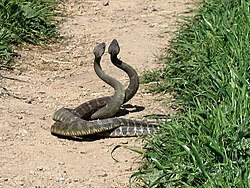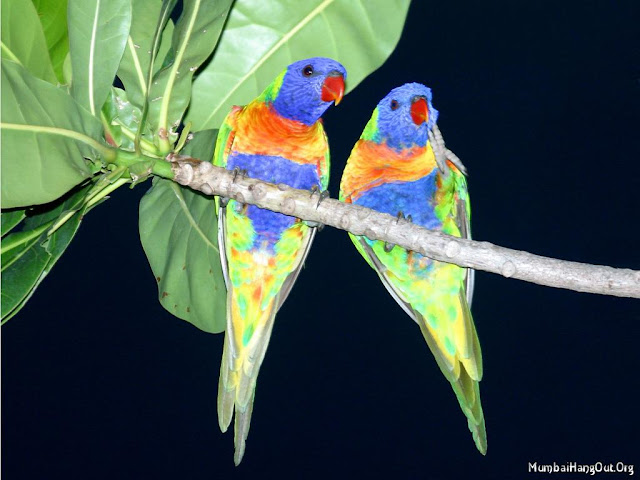The largest horn circumference on a steer measured 95.25 cm (37.5 in) on 6 May 2003 and belong to Lurch, an African watusi steer owned by Janice Wolf (USA) of Gassville, Arkansas, USA. Sadly, Lurch died at 3 p.m. on 22 May 2010 of a cancer at the base of one of the horns. The body has has been released to a local taxidermist, who will produce a full-sized taxidermy of the steer.
Wednesday, 20 March 2013
Largest horns
The largest horn circumference on a steer measured 95.25 cm (37.5 in) on 6 May 2003 and belong to Lurch, an African watusi steer owned by Janice Wolf (USA) of Gassville, Arkansas, USA. Sadly, Lurch died at 3 p.m. on 22 May 2010 of a cancer at the base of one of the horns. The body has has been released to a local taxidermist, who will produce a full-sized taxidermy of the steer.
Monday, 14 January 2013

Rattlesnakes
are a group of
venomous
snakes of
the genera
Crotalus
and
Sistrurus
of
the subfamily Crotalinae
("pit
vipers"). There are 32 known species
of rattlesnake,
with between 65-70 subspecies,
all
native to the Americas,
ranging from southern Alberta
and
southern British
Columbia in
Canada
to
Central Argentina.
Rattlesnakes
are predators
who
live in a wide array of habitats, hunting small animals such as birds
andodents.
They kill their prey with a venomous bite, rather than by
constricting.
All rattlesnakes possess a set of fangs
with
which they inject large quantities of hemotoxic
venom.
The venom travels through the bloodstream, destroying tissue
and
causing swelling, internal bleeding, and intense pain. Some species,
such as the Mojave
Rattlesnake,
additionally possess a neurotoxic
component
in their venom that causes paralysis
and
other nervous
symptoms.
The
threat of envenomation, advertised by the loud shaking of the titular
noisemaker ("rattle") at the end of their tail, deters many
predators. However, rattlesnakes fall prey to hawks,
weasels,
king
snakes,
and a variety of other species. Rattlesnakes are heavily preyed upon
as neonates,
while they are still weak and mentally immature. Very large numbers
of rattlesnakes are killed by humans. Rattlesnake populations in many
areas are severely threatened
byhabitat
destruction,poaching,
and extermination campaigns.
Rattlesnake
bites are the leading cause of snakebite
injuries
in North
America.
However, rattlesnakes rarely bite unless provoked or threatened; and
if treated promptly, the bites are rarely fatal.

The
black mamba
(Dendroaspis
polylepis),
also called thecommon black mamba or black-mouthed mamba,
is
the longestvenomous
snake inAfrica,
averaging around 2.5 to 3.2 m (8.2 to 10 ft) in length, and sometimes
growing to lengths of 4.45m (14.6 ft).It is named for the black
colour of the inside of the mouth rather than the colour of its
scales which varies from dull yellowish-green to a gun-metal grey. It
is also the fastest snake in the world, capable of moving at 4.32 to
5.4 metres per second (16–20 km/h, 10–12mph).[6]The
black mamba has a reputation for being very aggressive, but it
usually attempts to flee from humans like most snakes, unless it is
threatened.[7]Without
rapid and vigorousantivenomtherapy,
a bite from a black mamba is almost always fatal.
Taxonomy
The
black mamba was first described in 1864 byAlbert
Günther,
a German-born Britishzoologist,ichthyologist,
and herpetologist.
Soon after, a subspecies was identified,Dendroaspis
polylepis antinorii(Peters,
1873), but this is no longer accepted as distinct.
The
genus and species name are derived from Ancient
Greek words
–Dendroaspis
meaning
"tree asp" (dendro
is
"tree", while aspis
is
"asp" which is understood to mean a "venomous snake")
and polylepis,
"many scaled", from poly
"many"
and lepis
"scales".
The
name "black mamba" is given to the snake not because of its
body colour but because of the ink-black colouration of the inside of
its mouth, which it displays when threatened.
In
1896, Boulenger
combined
the species (Dendroaspis
polylepis)
as a whole with the eastern
green mamba,Dendroaspis
angusticeps,
and they were considered a single species from 1896
until
1946.[13]
It
is one of four species in the African snake genus Dendroaspis
that
are known as mambas.[14]
Description
The
head and upper part of a relatively young black mamba's body
The
adult black mamba's back skin colour is olive, brownish, gray, or
sometimes khaki. A young snake is lighter, but not light enough to be
confused with the different species of green
mamba.
Its underbody is cream-coloured, sometimes blended with green or
yellow.[5]
Dark
spots or blotches may speckle the back half of the body, and some
individuals have alternating dark and light scales near the
posterior, giving the impression of lateral bars.
The
inside of the mouth is dark blue to inky black. The head is large but
narrow and elongated, with the shape of a coffin.[15][16]
It
is a proteroglyphous snake, meaning it has immovable, fixed fangs at
the front of the maxilla.
The eyes are dark brown to black, with a silvery-white to yellow edge
on the pupils.[16]
These
snakes are strong but slender in body: adult specimens are 2.5 to 3 m
(8.2 to 9.8 ft) in length on average,
but
specimens measuring 3.1 to 3.75 m (10 to 12.3 ft) are relatively
common, and some specimens have reached lengths of 4.3 to 4.5 m (14
to 15 ft).[16][17]The
longest scientifically measured, wild-caught black mamba recorded was
4.48 metres (14.7ft) long, found in Zimbabwe.Adult
black mambas' slender but powerful body can typically weigh from 1.6
to 3.1 kg (3.5 to 6.8 lb).There is no real sexual dimorphism, and
both male and female snakes of this species have a similar
appearance and tend to be similar in size.
The
species is the second-longest venomous snake in the world, exceeded
in length only by the king
cobra.Information
regarding the lifespan of snakes in the wild is sparse; the longest
recorded lifespan of a captive black mamba is 14 years, but actual
maximum lifespans could be much greater.As they age, their
colouration tends to get darker.
Tuesday, 28 February 2012
Tuesday, 27 December 2011
Wednesday, 21 December 2011
Friday, 11 November 2011
Thursday, 10 November 2011
Monday, 31 October 2011
Saturday, 29 October 2011
Monday, 24 October 2011
Saturday, 22 October 2011
Porrot
Parrots, also known as psittacines are birds of the roughly 372 species in 86 genera that make up the orderPsittaciformes, found in most tropical and subtropical regions. The order is subdivided into three superfamilies: the Psittacoidea ('true' parrots), the Cacatuoidea (cockatoos) and the Strigopoidea (New Zealand parrots). Parrots have a generally pantropical distribution with several species inhabiting temperate regions in the Southern Hemisphere as well. The greatest diversity of parrots is in South America andAustralasia.
Characteristic
features of parrots include a strong, curved bill,
an upright stance, strong legs, and clawed zygodactyl
feet.
Many parrots are vividly coloured, and some are multi-coloured. The
plumage of cockatoos ranges from mostly white to mostly black, with a
mobile crest
of
feathers on the tops of their heads. Most parrots exhibit little or
no sexual
dimorphism.
They form the most variably sized bird order in terms of length.
The
most important components of most parrots' diets are seeds, nuts,
fruit, buds and other plant material. A few species sometimes eat
animals and carrion, while the loriesand
lorikeets
are
specialised for feeding on floral
nectar and
soft fruits. Almost all parrots nest in tree
hollows,
and lay white eggsfrom
which hatch altricial(helpless)
young.
Parrots,
along with ravens,
crows, jays and magpies,
are among the most intelligent birds, and the ability of some species
to imitate
human voices enhances
their popularity as pets.
Trapping
wild
parrots for the pet
trade,
as well as hunting,
habitat
loss and
competition
frominvasive
species,
has diminished wild populations, with parrots being subjected to more
exploitation than any other group of birds.[6]Measures
taken to conserve the habitats of some high-profile charismatic
species have
also protected many of the less charismatic species
Subscribe to:
Comments (Atom)




















